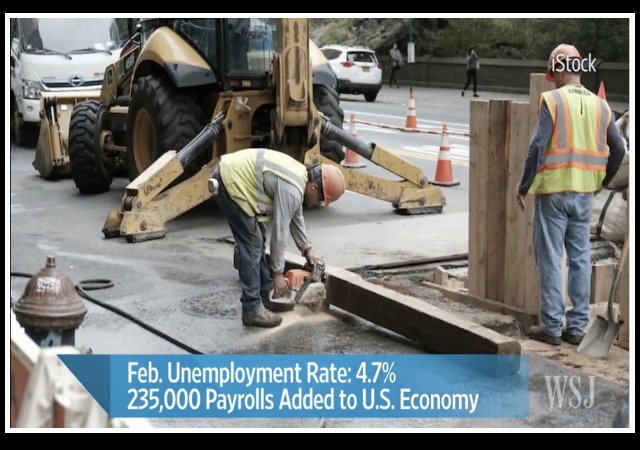U.S. Economy Adds 235,000 Jobs in February
But remain cautious due to slow economic growth.

The Labor Department has reported that the U.S. economy added 235,000 jobs in February. This stat has lowered the unemployment rate to 4.7% while wages went up “2.8 percent from February 2016.” From Bloomberg:
“We’re getting closer and closer to full employment,” said Ryan Sweet, an economist at Moody’s Analytics Inc. in West Chester, Pennsylvania. “Wages had been the one sore spot in the labor market data, and I think that’s coming through here. With inflation accelerating I think we’re going to start to see even stronger wage growth down the road.”
The prospect of a Fed rate increase at its meeting next week is “pretty much a slam dunk,” he said.
A lot of people have credited the warm winter with the creation in jobs, especially in the construction sector. Those companies added 58,000 workers:
Jesse Singh says better weather in February helped his firm, AZEK Building Products, keep pace with rising demand ahead of the summer building season.
“The warm weather is allowing construction firms to accelerate projects to be able to continue to meet their strong demand,” says Singh, whose company is based in Skokie, Ill.
Barclays economists Rob Martin and Michael Gapen noted this means “soft construction hiring in April and May” will likely occur.
Manufacturing jobs rose by 28,000, which is the “most since August 2013.” Retail positions dropped by 26,000 as more stores have announced closings and downsizing.
President Donald Trump gloated about the boost on Twitter, but experts stressed it’s too early in his administration to determine if he had anything to do with it:
“It’s too early to tell if the pickup in job growth in early 2017 is due to the Trump administration,” said Gus Faucher, deputy chief economist at PNC Financial Services Group, in a note to clients. “Given that few actual policies have changed, it could be that businesses are feeling more positive in the early days of the new administration.”
But, he added, “the underlying trends for the economy now are similar to those in 2016: more jobs and higher wages boosting consumer income and spending, and an improving housing market.”
Professor Jacobson noted the confidence in Americans in his post from last night.
It’s a good idea to remain cautious, though. The GOP should capitalize on this jobs report to implement real reform to keep bringing back the big paying jobs to America. Job growth isn’t all that great if it’s only about minimum wage jobs.
The GOP has a great opportunity to reduce regulations that keep companies from creating high paying jobs in America. Real tax reform, not tariffs, will also inspire these companies to keep creating these jobs here.
They need to do this because something appears off in the economy. The markets are strong, but 50 million people still have food stamps and the GDP grew only 1.9% in Q4, a part where jobs also grew. So the economy is still growing at a slow rate. The deficit must be lowered.
The government’s second look at gross domestic product in the fourth quarter showed a bigger increase in purchases by consumers than initially reported: 3% vs. 2.5%. What Americans spend has the biggest influence by far on GDP, the official scorecard for the U.S. economy.
Yet the increase in what consumers spent was offset by somewhat smaller gains in business investment and local and state spending, revised government figures reveal. As a result, GDP was unchanged from the original estimate.
So while more people have spent money, the large deficit cancels it out:
The bulk of the increase, however, was in health care. Americans are spending more on health care as the population ages, but the rising cost of coverage has also eaten into the budgets of U.S. households and forced them to pare back in other areas.
Business investment, long a sore spot in the current recovery, rose in the fourth quarter but not as much as previously reported. Spending on new equipment grew a smaller 1.9% instead of 3.1%, largely accounting for cuts from prior estimates.
The value of inventories added to warehouse shelves was also trimmed to $46.2 billion from $48.7 billion.
The trade figures in the final quarter of 2016 were little-changed from the initial read. Exports fell a slightly smaller 4% and imports rose a touch faster at 8.5%.
A larger deficit can be a drag on the U.S. economy. The wide trade deficit effectively cut fourth-quarter GDP in half.
Now, this could all change for Q1. I just saw that the New York Fed raised its Q1 and Q2 GDP Growth expectations to 3%, but the fed also over calculated the Q4 GDP.
The jobs report also gives the Federal reserve the fuel it needs to raise rates. Chairwoman Janet Yellen stated last week the Reserve would determine the rate raise depending on the market. That meeting will occur next week.
 DONATE
DONATE
Donations tax deductible
to the full extent allowed by law.








Comments
“full employment” my a55…
how many people are out of the w*rkforce again?
what is the w*rkforce participation rate again?
i classify this as #FakeNews
I noticed some writers were starting to make a big deal about the ADP numbers a couple days ago, which showed a much bigger jump. I suspected that might be a mistake on their part, since ADP numbers are notoriously jumpy and unreliable.
As the piece above relates, these numbers are good, not great, not awful. They mainly show that there’s a lot of work left to be done.
Employment will improve if McConnell gets of his duff and starts working on tax reform instead of playing obstructionist. Apparently he’s decided to take over Reid’s old roll.